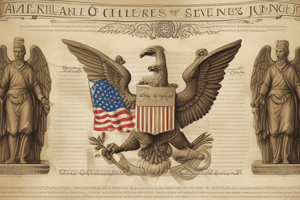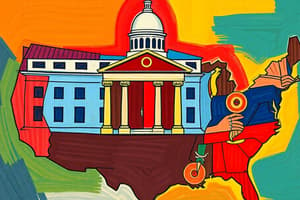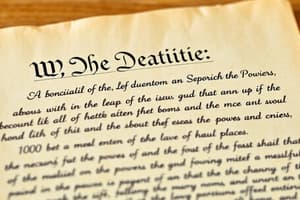Podcast
Questions and Answers
Which branch of government is responsible for interpreting the laws as per the Constitution?
Which branch of government is responsible for interpreting the laws as per the Constitution?
- Executive Branch
- State Government
- Legislative Branch
- Judicial Branch (correct)
What is the main purpose of the system of federalism in the United States?
What is the main purpose of the system of federalism in the United States?
- To eliminate the separate branches of government
- To concentrate power in the national government
- To establish an authoritarian form of government
- To maintain a balance of authority and prevent abuse of power (correct)
What concept divides the government into separate branches, each with distinct and independent powers?
What concept divides the government into separate branches, each with distinct and independent powers?
- Consolidation of Powers
- Checks and Balances
- Separation of Powers (correct)
- Concentration of Powers
What is the primary responsibility of the Executive Branch of the government?
What is the primary responsibility of the Executive Branch of the government?
What is the purpose of the system of checks and balances in the United States government?
What is the purpose of the system of checks and balances in the United States government?
Which doctrine generally prohibits the Legislative Branch from delegating its lawmaking authority to other entities?
Which doctrine generally prohibits the Legislative Branch from delegating its lawmaking authority to other entities?
What is the main purpose of the Bill of Rights?
What is the main purpose of the Bill of Rights?
Which amendment granted citizenship to former slaves and provided equal protection under the law for all citizens?
Which amendment granted citizenship to former slaves and provided equal protection under the law for all citizens?
What is the essence of dual sovereignty in federalism?
What is the essence of dual sovereignty in federalism?
What is the primary purpose of amending the Constitution?
What is the primary purpose of amending the Constitution?
Flashcards are hidden until you start studying
Study Notes
Constitution: Branches of Government, Separation of Powers, and Federalism
The Constitution is the foundation of the United States government system, which was established in 1787. It divides power among the three branches of government—legislative, executive, and judicial—and between the national government and the states. This system, known as federalism, was designed to prevent the abuse of power and maintain a balance of authority.
Branches of Government
The Constitution defined the three branches of government as follows:
- Legislative Branch: This branch is responsible for creating laws and consists of the Senate and the House of Representatives.
- Executive Branch: This branch is responsible for implementing and executing the laws and consists of the President and other executive agencies.
- Judicial Branch: This branch is responsible for interpreting the laws and consists of the Supreme Court and other lower courts.
Separation of Powers
The separation of powers is a concept that divides the government into separate branches, each with distinct and independent powers. This system was established to prevent any one branch from concentrating power and to create a system of checks and balances. Some key aspects of the separation of powers include:
- Checks and Balances: Each branch of government has the power to check the actions of the other branches, ensuring that no single branch becomes too powerful.
- Nondelegation doctrine: This doctrine generally prohibits the Legislative Branch from delegating its lawmaking authority to other entities, ensuring that the legislative power remains centralized.
Federalism
Federalism is the system of dividing political power between the national government and the states. The Constitution established a federal system, in which both the national government and the states have defined but limited powers. Some key aspects of federalism include:
- Dual Sovereignty: The national government and the states both have their own sovereign powers, which are distinct from each other.
- Concurrent Powers: The national government and the states share certain powers, such as the ability to tax and regulate commerce.
Bill of Rights
The Bill of Rights is the first ten amendments to the Constitution, which protect individual liberties and limit the power of the federal government. These amendments were added to address concerns about the protection of individual rights and the potential for the abuse of power by the new national government.
Amendments
Throughout the history of the United States, the Constitution has been amended several times to reflect the evolving needs of society and to address any perceived weaknesses in the government system. Some notable amendments include:
- Fourteenth Amendment: This amendment granted citizenship to former slaves and provided equal protection under the law for all citizens.
- Fifteenth Amendment: This amendment prohibited denying the right to vote based on race, color, or previous condition of servitude.
- Twenty-sixth Amendment: This amendment lowered the voting age to 18, allowing young people to participate in the political process.
In conclusion, the Constitution is the cornerstone of the United States government system, which combines the branches of government, the separation of powers, federalism, the Bill of Rights, and the ability to amend the document to adapt to changing times. This system was designed to maintain a balance of power and protect the rights of individuals, ensuring a stable and democratic society.
Studying That Suits You
Use AI to generate personalized quizzes and flashcards to suit your learning preferences.




